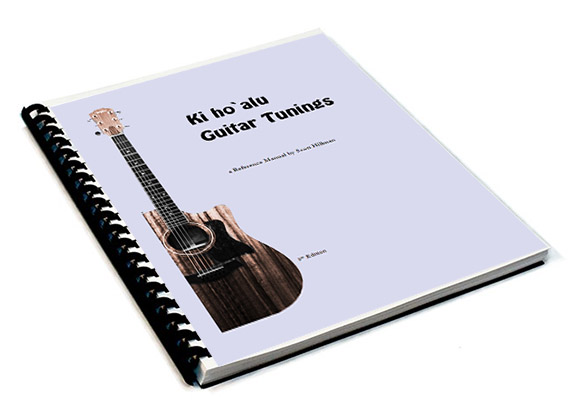About the Tunings Manual
Back in the day, even before I had heard much about slack key guitar, I developed an interest in modal tunings for the five-string banjo. With a background in music theory, I could figure out chord positions at various positions along the neck for a given tuning, but it was a time-consuming process, and patience is not my strongest attribute…
As a former software programmer, it made sense to me to think about automating the process of “calculating” chord positions for any tuning, using the power of the computer. So I wrote a program to do that.
Fast forward a couple of years – about the time I was developing an interest in slack key guitar, I met George Kahumoku at an acoustic club in San Jose where he was performing. In conversations with George about slack key tunings, I recalled the tunings calculator program, and realized that it could be a useful tool to apply to slack key tunings.
I dusted off the old program, added some new features to it that I thought would be useful to slack key students, and brought it to George’s Slack Key Guitar Workshop on Maui in 2006. The program could print out chord charts, and I ended up printing quite a few for students at the workshop. Because of the interest expressed by those students and others over time, I eventually compiled a set of chord charts for a variety of tunings into the Slack Key Tunings Manual, which is currently in its fifth edition.
The primary purpose of the manual is to provide a reference for slack key students and musicians who have a need to (1) find different ways to play a chord in a specific tuning, for example at different positions along the neck, or (2) develop a chord repertoire in a new tuning. The current edition of the manual contains chord charts for 20 slack key tunings. Out of the many slack key tunings documented to date, these tunings were selected for the manual primarily for two reasons:
- They represent the majority of the tunings used by both early and contemporary slack key artists found in available recordings today
- They represent the interesting ways that tunings can differ from one another and demonstrate the unique characteristics or “personality” of each of the tunings.
In addition to the chord charts, the manual also contains sections on music theory, information resources, and selected vamps.
Essential to the study of slack key guitar is developing an understanding of the musical form, its origins and cultural significance, and, mostly, listening to the music. The best advice I received regarding learning to play slack key guitar was to listen to as much slack key (and traditional Hawaiian music in general) as possible, whether live or recorded and, whenever possible, practice playing with others, regardless of your playing ability. So in addition to discussion about slack key tunings, I also plan to post — from time to time — information about local SoCal events (workshops, performances, kanikapilas), recordings, groups/clubs, and other listening and playing opportunities, to hopefully round out your studies of slack key guitar.
Customer Comments
“I’ve been meaning to write and thank you for the manual. I’ve spent a lot of time with it over the last few weeks and it’s an excellent resource. I’m an untrained musician, have never had lessons, and have really enjoyed the process of learning to play over the years for its own sake. Your book is clear and concise and helps me make sense of the fingerboard”. — Mark, Wayne, PA
“At first glance, it looks like you have put a lot of work into it and the manual should be very useful as Kimo is starting to get into the different tunings with me.” — Dean, La Habra, CA
“Scott Hillman has released a book of slack key tunings and related chords. Mahalo for doing this, Scott-I wish I had this when I was learning slack key!” — Jim “Kimo” West, well-known slack key guitarist and lead guitar player for Weird Al Jankovic
“….really enjoying the slack key tunings book..” — Morty, Corralitos, CA
“Scott, when we were talking last night I should have told you how helpful your book of Ki ho ‘alu tunings is. I keep it right with the music I work on each day and refer to it often. Mostly I use the patterns for parallel sixths and thirds to practice fretboard skills. So thank you!” — Angela, Long Beach, CA
“Ah so much mahalos scott. I’ve always yearned to dive more into slack key and what you are providing is a big stepping stone. So mahalo nui!” — Jon, Kualapuu, HI

